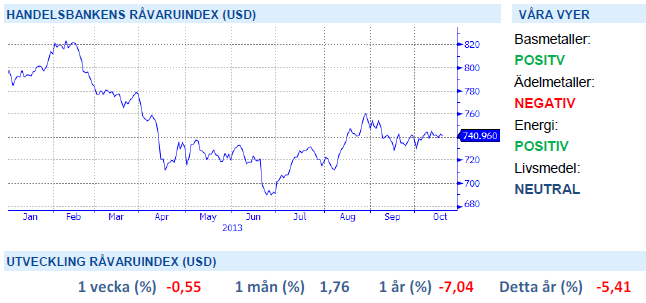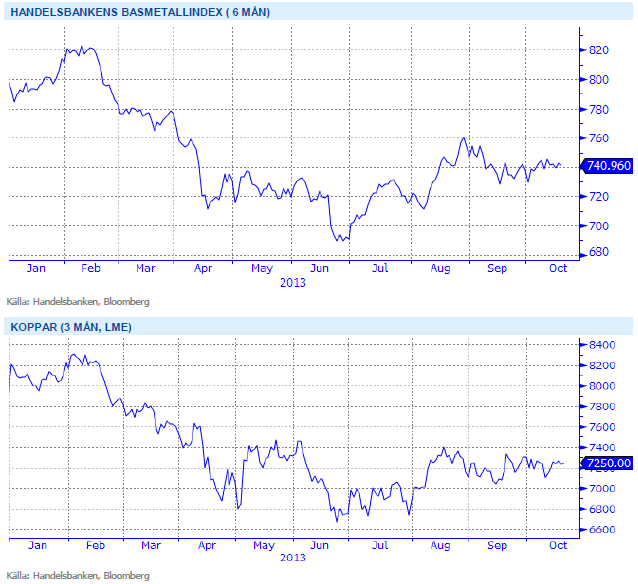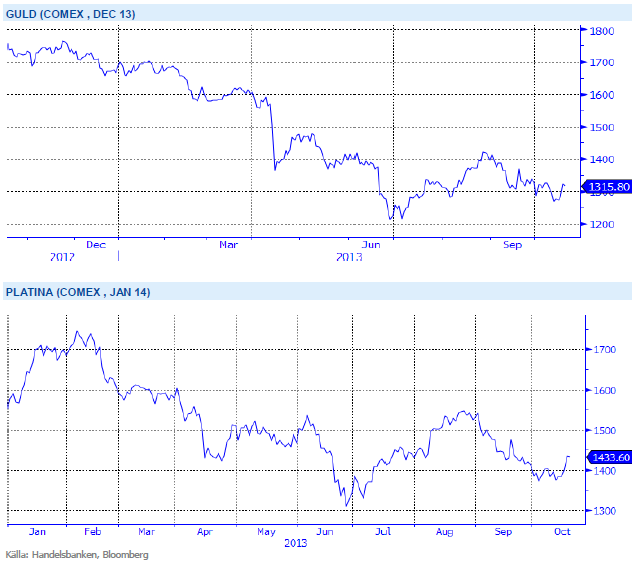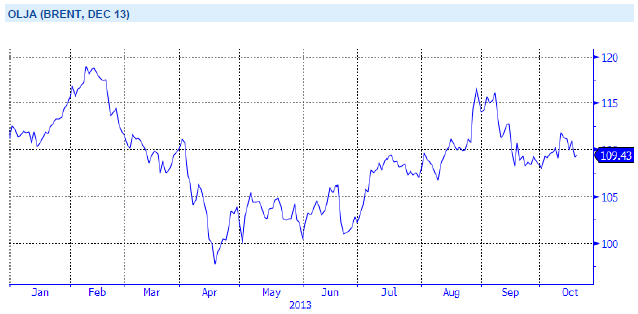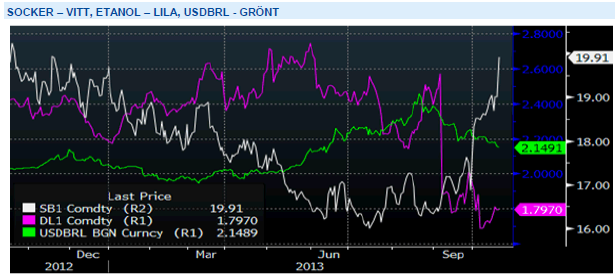Analys
SHB Råvarubrevet 18 oktober 2013

 Råvaror allmänt
Råvaror allmänt
Kinas BNP bekräftar vändning
En hörnpelare i vår tro på stigande råvarumarknad denna höst är att Kinas makro ska stå för höstens positiva överraskning och nattens BNP-siffra är ett tecken på detta, BNP-trenden i Q3 följde det sk Keqiang index uppåt, Keqiang är normaliserat mått på utlåning, järnvägstransporter och elproduktion – en bra indikator på tung industri i Kina. Kinaledningens stormöte i november är nästa större milstolpe i kommunikationen av vad som planeras kommande år. Vi tror att utvecklingen i Kina under H2 och prognoser för 2014 håller uppe kinaberoende råvaror.
Data har annars varit blandad i de stora ekonomierna på sistone. Överlag tror vi att de stora ekonomierna kommer fortsätta stärkas under de kommande månaderna då de erfar positiva efterdyningar från börsuppgångar runt om i världen. Med den akuta skuldtakskrisen i USA bakom oss så tror vi nu att marknaden kan fokusera på andra mer positiva ting. Sedan 2010 har hösten varit en stark säsong för finansiella tillgångar beroende på att det varit tiden då Fed lanserat QE stöd. Årets uteblivna nedskalning av QE är att betrakta som ett stöd och vi ser inget tecken på att höstens styrka ska brytas i år.
Basmetaller
Kina stärker metallerna
Basmetallerna har under veckan till stor del handlats på nyheter kring budgetkrisen i USA. Sedan faran (åtminstone för stunden) har blåst över kryper basmetallerna uppåt. Kinas bättre än väntad BNP-tillväxt för tredje kvartalet stärker metallerna under fredagen, 7,8 % mot väntade 7,5 %, (detta att jämföra mot andra kvartalets 7,5 %). Vi fortsätter att tro att en positiv makromiljö ska stärka basmetaller under hösten. Främst drivet av ett starkare Kina, världens största konsument av metaller.
Aluminium går dock mot trenden och backar 1,5% under veckan på plötsligt stigande lager. LME´s lager för metallen har under veckan stigit med nästan 2 %. Bly är den som sticker ut med en uppgång på över 3 %, medan övriga ligger runt 0,5 %.
Vi tror att Kinas tillväxt kommer överraska positivt under Q4 och Q1, vilket kommer stärka metallerna. Vi tror på: LONG BASMETALLER
Ädelmetaller
Korta positioner driver upp guldet
Torsdagen bjöd på ett kraftigt uppställ av guldet, drivet av att folk köpte tillbaks korta positioner. Rörelsen ser ut tappa kraft här kring 1320 dollar per uns, och vår mer negativa syn på ädelmetaller kvarstår. Under veckan som gått har hela ädelmetallsektorn stigit ganska mycket, och platina visar upp den starkaste uppgången på hela fem procent.
Vi är sedan förra veckan tillbaks i vår mer långsiktiga negativa vy på guldet, framför allt för att de faktorer som borde kunna driva upp priset kortsiktigt nu ebbat ut. När världen nu ser ut att gå in i en period av bättre tillväxt, och med ”flaskhalsar” i tillväxtekonomierna tror vi att det är rätt att favorisera konjunkturdrivna råvaror, och guldets närmast kontracykliska egenskaper kommer då att hämma prisutvecklingen.
Efter en uppgång under sommaren tror vi åter att guldets väg lutar utför. Vi tror på: SHRT GULD H
Energi
Fokus på USA
Oljemarknaden har varit väldigt stilla under veckan där det mesta av fokus riktats mot amerikanska budgetförhandlingar och diskussionerna mellan Iran, USA, Ryssland, Kina, Frankrike, UK och Tyskland där Iran antyder att man är redo att dra ned sin kärntekniska verksamhet för att lätta på de ekonomiska sanktionerna (nästa möte den 7-8 nov i Genève). Amerikansk sysselsättningsstatistik kom in något sämre än väntat och priset backar med 0.7 procent över veckan. Marknaden har fastnat i något av en range som blir snävare och snävare där vi bör se ett trendbrott snart.
Elpriset (Q114) har fallit med ca 2.5 procent under veckan efter att det lågtrycksdominerade vädret ligger kvar. Det blir mycket varmare, mer tillrinning och kärnkraften som föll ut oväntat förra veckan är på väg in igen. Även kol och utsläppsrätterna pressade något ytterligare under veckan. Energibalansen ser ut att förbättras med ca 1TWh från föregående vecka men visar fortsatt på ett underskott om 19 TWh mot normalen. Vi har varit positiva till elpriset sedan i augusti och ser detta som en fullt naturlig korrigering när energiutfallet dessutom ser ut att bli något bättre än väntat, förutsättningarna för ett stigande elpris mot vintern kvarstår dock med underskottet i balansen, marginalkostnadsstödet för kol (svårt att motivera amerikansk export om man ser till transportkostnader på uppemot 20 dollar från gruva till hamn och ytterligare en 10-11 dollar frakt till Europa…) och osäkerheten i kärnkraften.
Energiunderskott tillsammans med osäkerhet kring kärnkraftsverken inför vintern talar för högre elpris. Vi tror på: LONG EL
Livsmedel
Fortsatt blött i delar av Ryssland
Terminspriserna på vete handlas på ungefär samma nivå som för en vecka sedan i både Chicago och Paris. USA:s höstveteregioner faller en del regn, vilket gynnar redan sådd gröda. I Australien fortgår skörden med gott resultat. Argentina är fortfarande torrt och helt klart har vetet tagit skada. Det regnar dock fortfarande i stora delar av Ukraina varför en del ifrågasätter detta, det finns också stora frågetecken angående möjligheten för den sent sådda grödan att utvecklas tillräckligt väl inför vintern. Samma situation, om inte värre, råder i Ryssland där de enligt en del uppgifter haft den mest nederbördsrika septembermånaden sedan år 1885! Även där regnar det fortfarande i en del områden och kanske än mer i Ryssland ifrågasätts chanserna för den sent sådda grödan att utvecklas väl – sen sådd och blöta fält är inte idealiskt. Det finns gott om vete (och annan spannmål) att tillgå i världen, inte minst med en förväntad stor skörd i Australien på ingång – varför en eventuell fortsatt uppgång bör begränsas på kort sikt. Problemen i öst bör dock tas på allvar och följas noggrant då det kan få stora följder för nästa års produktionsnivå.
Kraftig nederbörd i Brasilien, världens topproducent av socker, försenar exporten för säsongen. Det blöta vädret har sen i mitten av juli gett stöd till sockerpriset som noteras upp 25 procent från nivåer kring produktionskostnad och står i nuläget på ett årshögsta. En starkare brasiliansk real mot dollarn är en annan orsak bakom den kraftiga uppgången. Det starka sockerpriset har således drivit med sig etanolen som har vänt upp från treårshögsta.
Försening av skörden efter längre perioder av nederbörd i Brasilien samt en stark brasiliansk real driver upp sockerpriset. Vi tror på: BULL SOCKER
Handelsbankens Råvaruindex
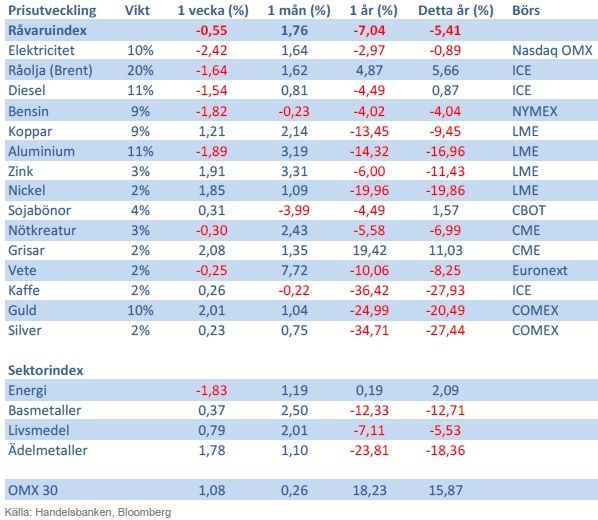
Handelsbankens råvaruindex består av de underliggande indexen för respektive råvara. Vikterna är bestämda till hälften från värdet av nordisk produktion (globala produktionen för sektorindex) och till hälften från likviditeten i terminskontrakten.
[box]SHB Råvarubrevet är producerat av Handelsbanken och publiceras i samarbete och med tillstånd på Råvarumarknaden.se[/box]
Ansvarsbegränsning
Detta material är producerat av Svenska Handelsbanken AB (publ) i fortsättningen kallad Handelsbanken. De som arbetar med innehållet är inte analytiker och materialet är inte oberoende investeringsanalys. Innehållet är uteslutande avsett för kunder i Sverige. Syftet är att ge en allmän information till Handelsbankens kunder och utgör inte ett personligt investeringsråd eller en personlig rekommendation. Informationen ska inte ensamt utgöra underlag för investeringsbeslut. Kunder bör inhämta råd från sina rådgivare och basera sina investeringsbeslut utifrån egen erfarenhet.
Informationen i materialet kan ändras och också avvika från de åsikter som uttrycks i oberoende investeringsanalyser från Handelsbanken. Informationen grundar sig på allmänt tillgänglig information och är hämtad från källor som bedöms som tillförlitliga, men riktigheten kan inte garanteras och informationen kan vara ofullständig eller nedkortad. Ingen del av förslaget får reproduceras eller distribueras till någon annan person utan att Handelsbanken dessförinnan lämnat sitt skriftliga medgivande. Handelsbanken ansvarar inte för att materialet används på ett sätt som strider mot förbudet mot vidarebefordran eller offentliggörs i strid med bankens regler.
Analys
Sell the rally. Trump has become predictable in his unpredictability

Hesitant today. Brent jumped to an intraday high of $66.36/b yesterday after having touched an intraday low of $60.07/b on Monday as Indian and Chinese buyers cancelled some Russian oil purchases and instead redirected their purchases towards the Middle East due to the news US sanctions. Brent is falling back 0.4% this morning to $65.8/b.

It’s our strong view that the only sensible thing is to sell this rally. In all Trump’s unpredictability he has become increasingly predictable. Again and again he has rumbled about how he is going to be tough on Putin. Punish Putin if he won’t agree to peace in Ukraine. Recent rumbling was about the Tomahawk rockets which Trump threatened on 10 October and 12 October to sell/send to Ukraine. Then on 17 October he said that ”the U.S. didn’t want to give away weapons (Tomahawks) it needs”.
All of Trump’s threats towards Putin have been hot air. So far Trump’s threats have been all hot air and threats which later have evaporated after ”great talks with Putin”. After all these repetitions it is very hard to believe that this time will be any different. The new sanctions won’t take effect before 21. November. Trump has already said that: ”he was hoping that these new sanctions would be very short-lived in any case”. Come 21. November these new sanctions will either evaporate like all the other threats Trump has thrown at Putin before fading them. Or the sanctions will be postponed by another 4 weeks or 8 weeks with the appearance that Trump is even more angry with Putin. But so far Trump has done nothing that hurt Putin/Russia. We can’t imagine that this will be different. The only way forward in our view for a propre lasting peace in Ukraine is to turn Ukraine into defensive porcupine equipped with a stinging tail if need be.
China will likely stand up to Trump if new sanctions really materialize on 21 Nov. Just one country has really stood up to Trump in his tariff trade war this year: China. China has come of age and strength. I will no longer be bullied. Trump upped tariffs. China responded in kind. Trump cut China off from high-end computer chips. China put on the breaks on rare earth metals. China won’t be bullied any more and it has the power to stand up. Some Chinese state-owned companies like Sinopec have cancelled some of their Russian purchases. But China’s Foreign Ministry spokesperson Guo Jiakun has stated that China “oppose unilateral sanctions which lack a basis in international law and authorization of the UN Security Council”. Thus no one, not even the US shall unilaterally dictate China from whom they can buy oil or not. This is yet another opportunity for China to show its new strength and stand up to Trump in a show of force. Exactly how China choses to play this remains to be seen. But China won’t be bullied by over something as important as its oil purchases. So best guess here is that China will defy Trump on this. But probably China won’t need to make a bid deal over this. Firstly because these new sanctions will either evaporate as all the other threats or be postponed once we get to 21 November. Secondly because the sanctions are explicit towards US persons and companies but only ”may” be enforced versus non-US entities.
Sanctions is not a reduction in global supply of oil. Just some added layer of friction. Anyhow, the new sanctions won’t reduce the supply of Russian crude oil to the market. It will only increase the friction in the market with yet more need for the shadow fleet and ship to ship transfer of Russian oil to dodge the sanctions. If they materialize at all.
The jump in crude oil prices is probably due to redirections of crude purchases to the Mid-East and not because all speculators are now turned bullish. Has oil rallied because all speculators now suddenly have turned bullish? We don’t think so. Brent crude has probably jumped because some Indian and Chinese oil purchasers of have redirected their purchases from Russia towards the Mid-East just in case the sanctions really materializes on 21 November.
Analys
Brent crude set to dip its feet into the high $50ies/b this week

Parts of the Brent crude curve dipping into the high $50ies/b. Brent crude fell 2.3% over the week to Friday. It closed the week at $61.29/b, a slight gain on the day, but also traded to a low of $60.14/b that same day and just barely avoided trading into the $50ies/b. This morning it is risk-on in equities which seems to help industrial metals a little higher. But no such luck for oil. It is down 0.8% at $60.8/b. This week looks set for Brent crude to dip its feet in the $50ies/b. The Brent 3mth contract actually traded into the high $50ies/b on Friday.

The front-end backwardation has been on a weakening foot and is now about to fully disappear. The lowest point of the crude oil curve has also moved steadily lower and lower and its discount to the 5yr contract is now $6.8/b. A solid contango. The Brent 3mth contract did actually dip into the $50ies/b intraday on Friday when it traded to a low point of $59.93/b.
More weakness to come as lots of oil at sea comes to ports. Mid-East OPEC countries have boosted exports along with lower post summer consumption and higher production. The result is highly visibly in oil at sea which increased by 17 mb to 1,311 mb over the week to Sunday. Up 185 mb since mid-August. On its way to discharge at a port somewhere over the coming month or two.
Don’t forget that the oil market path ahead is all down to OPEC+. Remember that what is playing out in the oil market now is all by design by OPEC+. The group has decided that the unwind of the voluntary cuts is what it wants to do. In a combination of meeting demand from consumers as well as taking back market share. But we need to remember that how this plays out going forward is all at the mercy of what OPEC+ decides to do. It will halt the unwinding at some point. It will revert to cuts instead of unwind at some point.
A few months with Brent at $55/b and 40-50 US shale oil rigs kicked out may be what is needed. We think OPEC+ needs to see the exit of another 40-50 drilling rigs in the US shale oil patches to set US shale oil production on a path to of a 1 mb/d year on year decline Dec-25 to Dec-26. We are not there yet. But a 2-3 months period with Brent crude averaging $55/b would probably do it.
Oil on water increased 17 mb over the week to Sunday while oil in transit increased by 23 mb. So less oil was standing still. More was moving.

Crude oil floating storage (stationary more than 7 days). Down 11 mb over week to Sunday

The lowest point of the Brent crude oil curve versus the 5yr contract. Weakest so far this year.

Crude oil 1mth to 3mth time-spreads. Dubai held out strongly through summer, but then that center of strength fell apart in late September and has been leading weakness in crude curves lower since then.

Analys
Crude oil soon coming to a port near you

Rebounding along with most markets. But concerns over solidity of Gaza peace may also contribute. Brent crude fell 0.8% yesterday to $61.91/b and its lowest close since May this year. This morning it is bouncing up 0.9% to $62.5/b along with a softer USD amid positive sentiment with both equities and industrial metals moving higher. Concerns that the peace in Gaza may be less solid than what one might hope for also yields some support to Brent. Bets on tech stocks are rebounding, defying fears of trade war. Money moving back into markets. Gold continues upwards its strong trend and a softer dollar helps it higher today as well.

US crude & products probably rose 5.6 mb last week (API) versus a normal seasonal decline of 2.4 mb. The US API last night partial and thus indicative data for US oil inventories. Their data indicates that US crude stocks rose 7.4 mb last week, gasoline stocks rose 3.0 mb while Distillate stocks fell 4.8 mb. Altogether an increase in commercial crude and product stocks of 5.6 mb. Commercial US crude and product stocks normally decline by 2.4 mb this time of year. So seasonally adjusted the US inventories rose 8 mb last week according to the indicative numbers by the API. That is a lot. Also, the counter seasonal trend of rising stocks versus normally declining stocks this time of year looks on a solid pace of continuation. If the API is correct then total US crude and product stocks would stand 41 mb higher than one year ago and 6 mb higher than the 2015-19 average. And if we combine this with our knowledge of a sharp increase in production and exports by OPEC(+) and a large increase in oil at sea, then the current trend in US oil inventories looks set to continue. So higher stocks and lower crude oil prices until OPEC(+) switch to cuts. Actual US oil inventory data today at 18:00 CET.
US commercial crude and product stocks rising to 1293 mb in week 41 if last nights indicative numbers from API are correct.

Crude oil soon coming to a port near you. OPEC has lifted production sharply higher this autumn. At the same time demand for oil in the Middle-East has fallen as we have moved out of summer heat and crude oil burn for power for air-conditioning. The Middle-East oil producers have thus been able to lift exports higher on both accounts. Crude oil and condensates on water has shot up by 177 mb since mid-August. This oil is now on its way to ports around the world. And when they arrive, it will likely help to lift stocks onshore higher. That is probably when we will lose the last bit of front-end backwardation the the crude oil curves. That will help to drive the front-month Brent crude oil price down to the $60/b line and revisit the high $50ies/b. Then the eyes will be all back on OPEC+ when they meet in early November and then again in early December.
Crude oil and condensates at sea have moved straight up by 177 mb since mid-August as OPEC(+) has produced more, consumed less and exported more.

-

 Nyheter3 veckor sedan
Nyheter3 veckor sedanGoldman Sachs höjer prognosen för guld, tror priset når 4900 USD
-

 Nyheter4 veckor sedan
Nyheter4 veckor sedanBlykalla och amerikanska Oklo inleder ett samarbete
-

 Nyheter3 veckor sedan
Nyheter3 veckor sedanGuld nära 4000 USD och silver 50 USD, därför kan de fortsätta stiga
-

 Nyheter2 veckor sedan
Nyheter2 veckor sedanLeading Edge Materials är på rätt plats i rätt tid
-

 Nyheter3 veckor sedan
Nyheter3 veckor sedanNytt prisrekord, guld stiger över 4000 USD
-

 Nyheter4 veckor sedan
Nyheter4 veckor sedanEtt samtal om guld, olja, koppar och stål
-

 Analys4 veckor sedan
Analys4 veckor sedanOPEC+ will likely unwind 500 kb/d of voluntary quotas in October. But a full unwind of 1.5 mb/d in one go could be in the cards
-
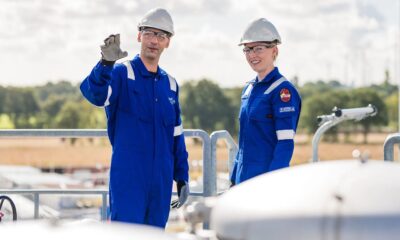
 Nyheter4 veckor sedan
Nyheter4 veckor sedanNeptune Energy bekräftar enorma litiumfyndigheter i Tyskland


